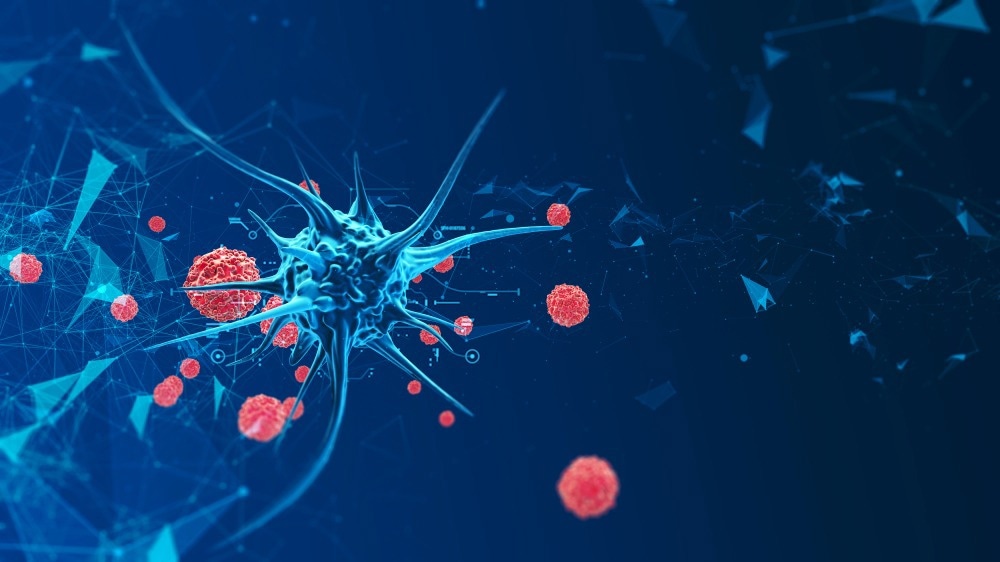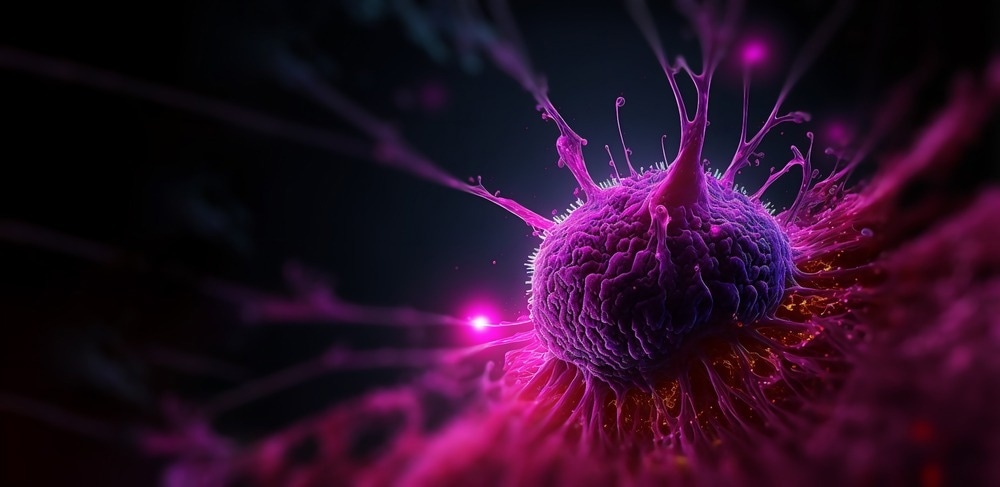Nanoparticle technology has become a revolutionary breakthrough for cancer therapeutics, with nanoparticles and nanoscale devices being between 1 and 100 nm in size.

Image Credit: Antiv/Shutterstock.com
To better comprehend how small the nanoscale is, these devices are between one hundred to ten thousand times smaller than human cells, similar to large biomolecules, including enzymes and receptors.
The impact of using these nanosized molecules in cancer treatment holds monumental potential, with the capacity to target tumors more precisely and effectively. The revolutionary impact nanotechnology and nanoparticles can have in cancer therapeutics and medicine will be further explored in this article.
Background
Cancer is one of the largest causes of death in the United States, rated as being the second highest cause of mortality. Various cancers hold a range of prognoses, with some being rare and difficult to treat and others being more commonly found and treatable. However, in both circumstances, treatment can be strenuous and leave patients with substantial toxicity with adverse complications due to the systemic approach of traditional standard-of-care therapeutics.
Most tumors are heterogeneous, resulting in different characteristics demonstrated by different tumors; this can cause difficulty in treating tumors due to a patient’s genomic profile.
Genomic mutations can cause a patient to respond in various ways to treatments, leading to unsuccessful treatment management and recurrent and resistant tumors.
Additionally, systemic treatment options such as chemotherapy can cause systemic toxicity, and due to chemotherapy drugs being non-specific, a range of complications and adverse effects are likely.
The introduction of nanotechnology to cancer therapy through the use of nanoparticles has shown promising results in reducing toxicity as well as minimizing the negative effects of treatment.
Importance of the Nanoscale in Cancer Nanomedicine
Precision medicine and therapy have become an increasingly popular area of interest for researchers, with nanotechnology spearheading this path. The use of nanoparticles, which are on a nanoscale, between 1 and 100 nm in size, can result in monumental differences when applied to therapeutics.
The use of these particles in targeted therapy, such as nanoparticle-based drug delivery systems, has shown good pharmacokinetics, higher targetability levels, decreased side effects and drug resistance. By carrying the drug cargo within the nanoparticle to the target tumor site, cancerous cells can be found with higher precision, leading to targeted treatment without harming surrounding healthy cells or the overall health of patients.
To put these particles into a comprehendible scale, hemoglobin, which is an oxygen-carrying molecule in red blood cells, is sized as being approximately 5 nm in diameter. Nanoscale devices or molecules that are smaller than 50 nm have the capacity to enter the majority of cells in the human body. In contrast, even smaller molecules, such as those smaller than 20 nm, can move out of blood vessels as well as circulate the entire body.
The nanoscale of these molecules enables easy access to all areas of the body, even the brain, by crossing the blood-brain barrier, an obstacle that most drugs fail to access due to being too large. Additionally, the small size of nanoparticles allows direct interaction with biological systems and molecules, with access to their surfaces as well as having the capacity to enter cells. This demonstrates the potentially limitless applications for nanoparticles in medicine, both in cancer treatment as well as other diseases, due to the precise targetability of these significant particles.
Other Nanoparticle Benefits
While the nanoscale is a significant feature of nanoparticles, it is not the only feature; other elements of this novel technology help to enhance the efficacy of drug treatment.
This can include surface functionalization of nanoparticles, which can also increase efficacy, as nanoparticles being functionalized with ligands on their surface to actively target the tumor cells can aid in higher precision targeting.
Interestingly, passive targeting can also be used effectively with nanoparticles through the enhanced permeability and retention effect. This is due to the leaky vasculature of tumors that can also aid in accumulating nanoparticles within the tumor site as fast-growing tumors do not have effective lymphatic systems to clear out these drug-delivering nanoparticles. Once the nanoparticles are in the tumor site, there will be a high level of drug accumulation in the targeted tumor region, resulting in the effective elimination of cancer cells.

Image Credit: CI Photos/Shutterstock.com
Challenges
While the use of nanoparticles for tumor treatment may hold potential, there has not been a significant number of nanomedicines that have been approved by the FDA.
The challenge of tumor treatment involves its heterogeneity as the same tumor may have varied manifestations and genomic mutations in different patients; for example, one patient may have resistance against a standard chemotherapy drug, while another patient may not. This demonstrates the importance of precision treatment as opposed to the ‘one-size-fits-all’ approach, as the same drug may not be effective for everyone.
Additionally, it is also difficult to predict treatment outcomes for nanoparticle-based systems through measuring the biodistribution as the heterogenous distribution of nanoparticles that is relative to the distribution of free drug molecules is frequently unmatched. However, a proof-of-concept study published in the journal Scientific Reports aimed to use mathematical modeling in order to bridge the gap between nanoparticle uptake and treatment efficacy in cancer.
This is significant as while the size of nanoparticles enables high uptake into cells and targeted cancer regions, and it does not always translate into being effective for tumor treatment.
Future Outlook
The nanoscale feature of nanoparticles is significant for effective cancer treatment, as this dramatically decreased size allows drugs to be targeted to tumor regions and reduce the toxicity of the drug as a whole. Targeting cancer through direct interaction can reduce and prevent the toxic effects of chemotherapy and preserve healthy cells in patients, providing them with a better quality of life, and decreasing the risk of organ failure and even death.
While most benefits of using nanotechnology and nanoparticle in treatments are based on the size of these particles, it may not be the sole reason this concept is effective. The use of surface functionalization can also contribute to the precise targetability of cancer cells through ligands that identify markers on the surface of target cells.
Additionally, the uptake of nanoparticles does not always translate to more effective treatment; however, research into mathematical modeling may aid in nanoparticle-based drug delivery systems becoming closer to becoming a standard treatment option for cancer.
References and Further Reading
Benefits of nanotechnology for cancer (2017) National Cancer Institute.
Brocato, T.A. et al. (2018) “Understanding the connection between nanoparticle uptake and cancer treatment efficacy using mathematical modeling,” Scientific Reports, 8(1). https://doi.org/10.1038/s41598-018-25878-8.
Gavas, S., Quazi, S. and Karpiński, T.M. (2021) “Nanoparticles for cancer therapy: Current progress and challenges,” Nanoscale Research Letters, 16(1). https://doi.org/10.1186/s11671-021-03628-6.
Yu, Z. et al. (2021) “Nanoparticles: A new approach to upgrade cancer diagnosis and treatment,” Nanoscale Research Letters, 16(1). https://doi.org/10.1186/s11671-021-03489-z.
Disclaimer: The views expressed here are those of the author expressed in their private capacity and do not necessarily represent the views of AZoM.com Limited T/A AZoNetwork the owner and operator of this website. This disclaimer forms part of the Terms and conditions of use of this website.